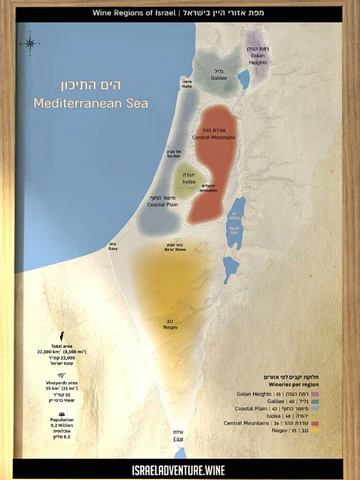This spring, your Member Subscription box contained something unique: six different wines to represent the six wine regions in Israel. What used to be defined as five regions has been clarified to six and we wanted to highlight each region and the uniqueness of the wines that typify each of the terroirs from which they stem.
In this feature, take a look at each of the six wine regions, what makes them so unique, and a bit about each of the wines you received in your box.

WINE REGION: GOLAN HEIGHTS
The Golan Heights can feel at times like Israel’s Wild West. It is sparsely populated by Druze and Jewish settlements and abounds with raw nature: dormant volcanoes, waterfalls, green meadows with roaming cattle and the occasional cowboy. Topographically the Golan Heights is a “tilted plateau” with Mt. Hermon (7,296 feet) towering over the north and sloping down to some 984 feet above sea level in the south. Until an estimated 100,000 years ago the active volcanoes in the north poured lava down south covering the limestone bedrock with a layer of basalt. It is one of Israel’s cooler regions and enjoys snowy winters in the north. There is even a ski resort on Mt. Hermon.
Elevation: 984-3,608 feet (300-1,100 meters)
Main Soil Types: Basalt and Limestone
Average Daily Temperature: Lows: 32-59 degrees F; Highs: 48-80 degrees F
Featured Winery this Quarter: Golan Heights Winery
WINE REGION: GALILEE
Galilee is the area north of the Carmel and Gilboa mountain ridges. It extends from the Israeli coastal plain in the west to the Sea of Galilee and the Jordan Valley in the east, and up to the Lebanese border in the north. Most of Galilee consists of rocky terrain, at heights between 1,640 and 2,296 feet (500 and 700 m) above sea level. There are several high mountains in the region, including Mt. Tabor and Mt. Meron, which have relatively low temperatures and high rainfall. The Galilee is home to diverse communities: Muslim, Jewish, Bahai, Christian, Druze, Bedouin, Maronite, and Circassian. The main economic activities include agriculture, tourism-related enterprises, and light industry.
Elevation: 0-3,937 feet (0-1,200 meters)
Main Soil Types: Limestone, Basalt, and Terra rossa
Average Daily Temperature: 39-60 degrees F; Highs: 50-82 degrees F
Featured Winery this Quarter: Lotem Organic Winery
WINE REGION: COASTAL PLAINS
The Coastal Plain extends 116 miles (187 km) along the Mediterranean Sea’s sandy shoreline, bordered by stretches of fertile farmland, ranging between four and forty kilometers wide (2.5-25 miles). About 57% of Israel’s population lives in the coastal plain, mostly in the Tel Aviv-Yafo and Haifa metropolitan areas. Its strategic location has made it favorable for port cities for thousands of years, some still with ancient architecture and lively markets. Many compare its climate to that of southern France, which prompted the planting of grape varieties such as Carignan, Grenache, and Syrah. In this region the modern wine industry of Israel began. Look out for Old Vine Carignan wines, some of these vineyards were planted in the late 19th century.
Elevation: 0-656 feet (0-200 meters)
Main Soil Types: Limestone, Clay, Terra rossa, and Sandstone
Average Daily Temperature: Lows: 50-63 degrees F; Highs: 63-82 degrees F
Featured Winery this Quarter: Alona Estate Winery
WINE REGION: JUDEAN HILLS
Judea is Israel’s first internationally recognized wine appellation, with its two sub-regions: Judean Hills and Judean Foothills. When driving from Tel Aviv towards Jerusalem, you will notice the view suddenly changes from agricultural plains to forested hills. It has a diverse range of microclimates, many farms and some impressive monasteries. It abounds with ancient wine presses and fruit-filled terraces. The region is filled with culinary adventures from a cheese maker in a hidden cave amidst a pine forest, to a fresh tahini press with different types of the iconic sesame seed paste, even a black one.
Elevation: 492-2952 feet (150-900 meters)
Main Soil Types: Basalt and Limestone
Average Daily Temperature: Lows: 37-55 degrees F; Highs: 53-80 degrees F
Featured Winery this Quarter: Ella Valley Winery
WINE REGION: CENTRAL MOUNTAINS
The Central Mountains stretches from north to south through Israel and the West Bank. It is marked by rocky limestone hills, old terraced slopes, green valleys filled with olive groves and ancient ruins. This fertile land has been inhabited by agricultural communities for thousands of years. The population consists of Muslim and Christian Palestinians and Jews. This region is beyond the Green Line of Israel and crossing it may entail passing through Israeli military checkpoints. Much of this region is under Palestinian Authority Control and entry to some areas is forbidden for Israeli citizens.
Elevation: 1,640-2952 feet (500-900 meters)
Main Soil Types: Limestone
Average Daily Temperature: Lows: 39-64 degrees F; Highs: 51-80 degrees F
Featured Winery this Quarter: Psagot Winery
WINE REGION: NEGEV
The Negev, comprising about half of Israel’s land area, is also the most arid. It consists of clay heights, low sandstone hills, canyons and wadis, which can experience flash floods when it rains during winter. It is sparsely inhabited with a few towns, agricultural and Bedouin communities and single-family homesteads. Most of this region’s grapes grow in the high elevation parts of the Negev, enjoying cold nights even during the summer. It is the youngest wine region in the country’s new era and is rapidly showing some unique qualities and high potential. Mitzpe Ramon is a great place for star watching thanks to low light pollution, especially during August when there are meteor showers. Further south, by the Red Sea, is the touristic city of Eilat. Sunsets (and sunrises) over the Red Sea are magical, when the red granite mountain peaks reflect on the water.
Elevation: 1,640-2,952 feet (500-900 meters)
Main Soil Types: Clay and Sandstone
Average Daily Temperature: Lows: 41-59 degrees F; Highs: 53-82 degrees F
Featured Winery this Quarter: Nana Estate Winery
*The information in this feature is compliments of the book: Wine Journey, An Israeli Adventure by Israel Adventure




